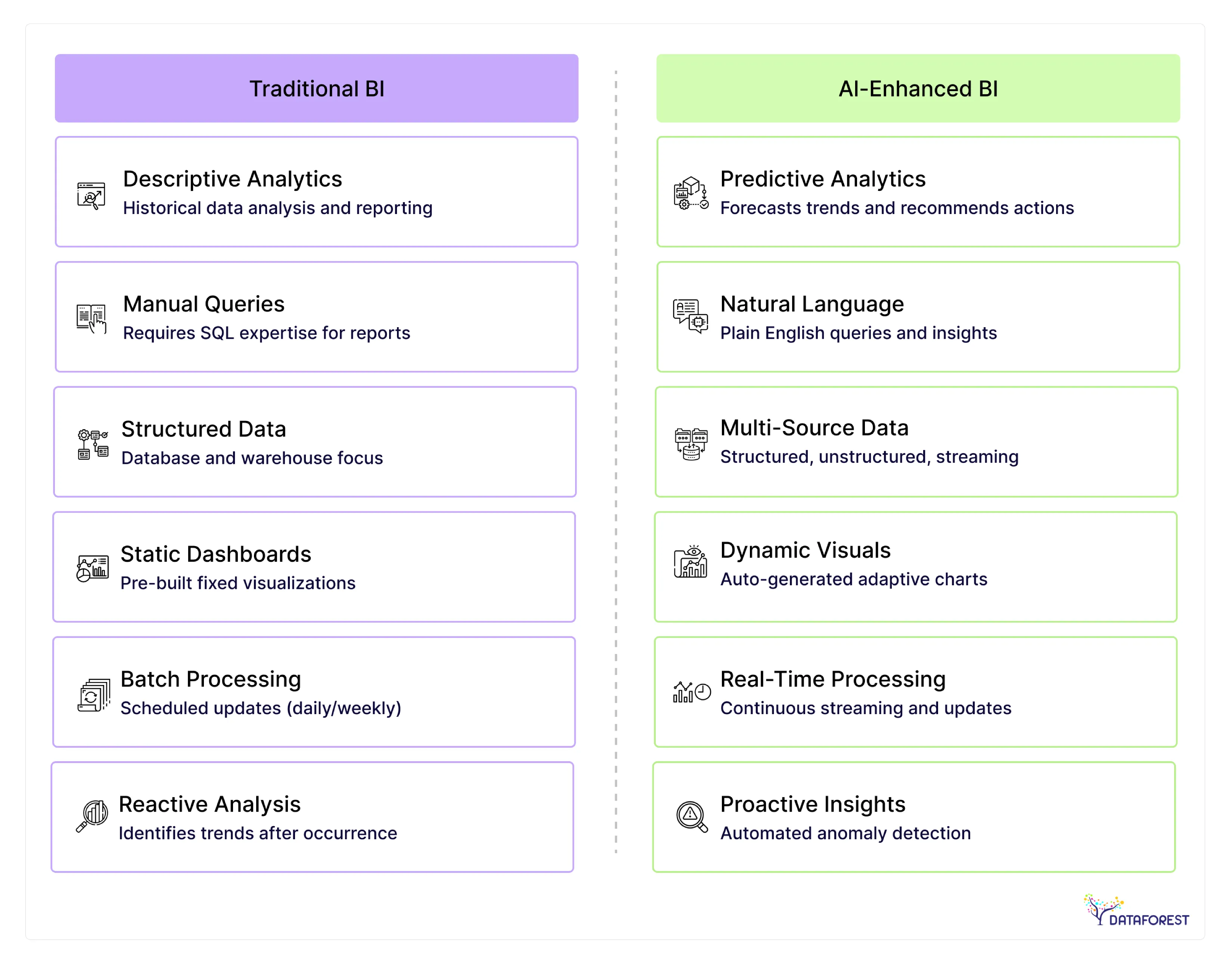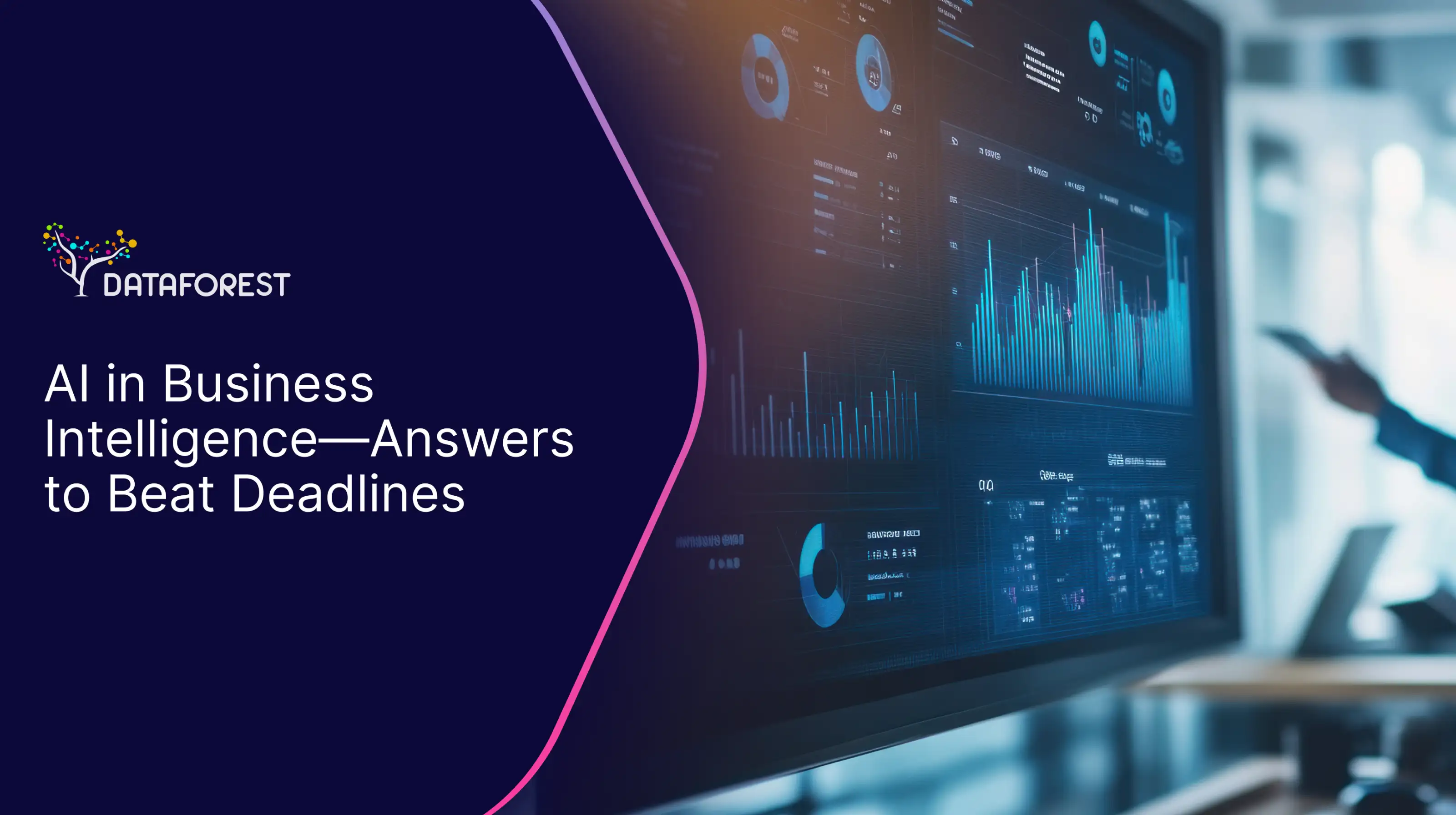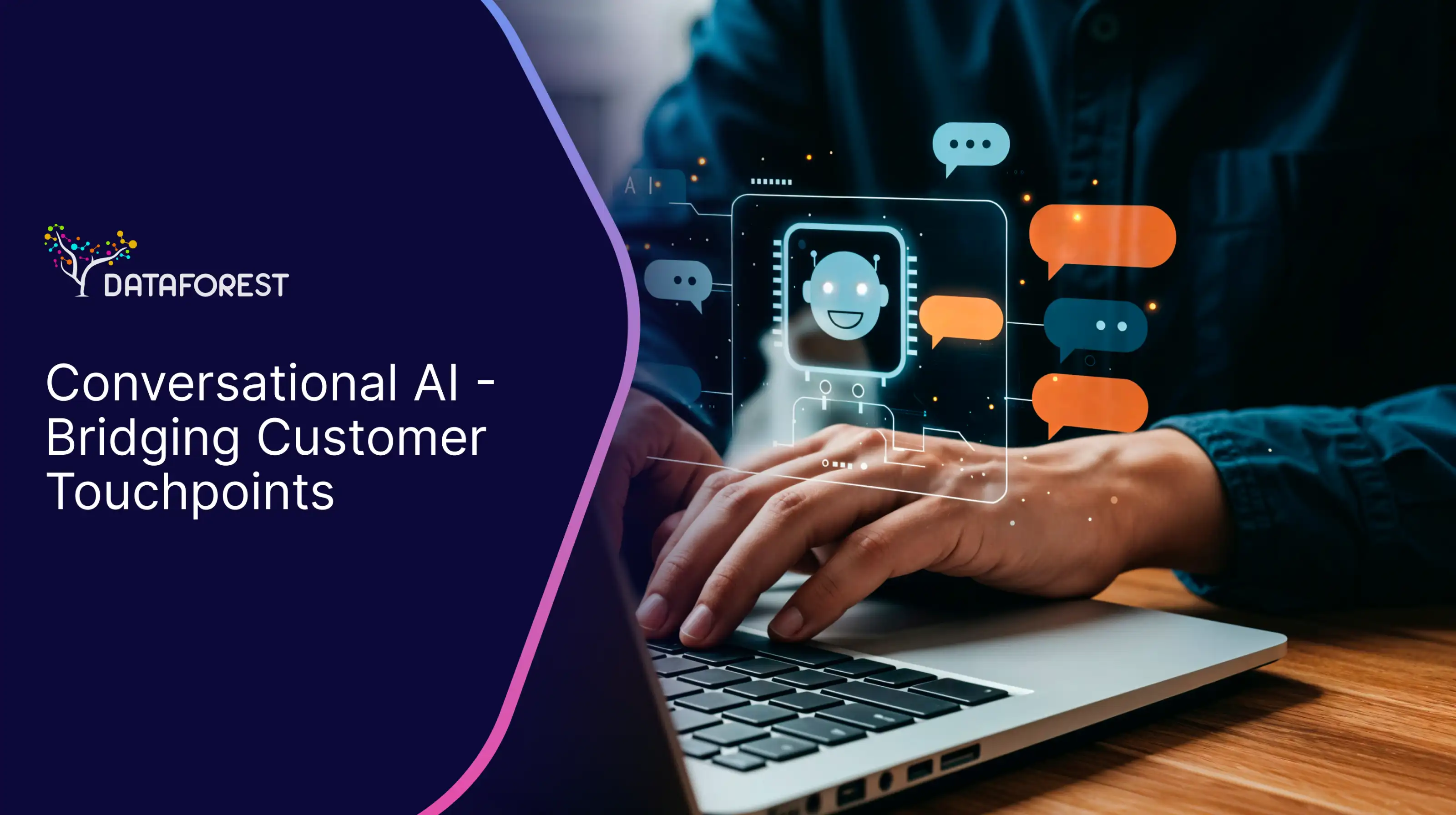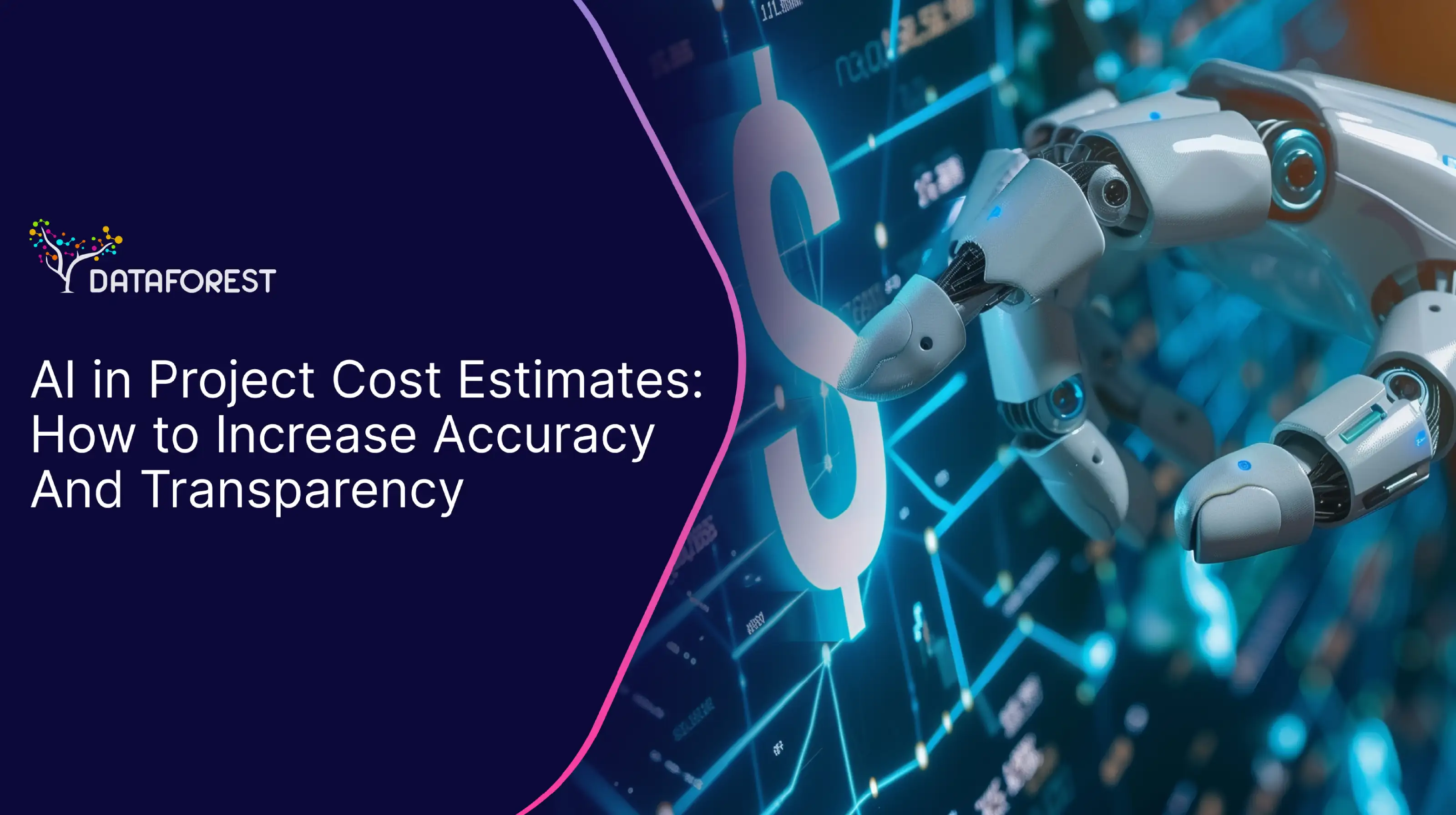A retail chain's sales dropped 15% in three regions, but executives only discovered this two weeks after the decline began. AI-powered business intelligence now flags revenue anomalies within 6 hours and automatically cross-references weather data, competitor promotions, and inventory levels to explain why. For the same purpose, you can book a call with us.

Why Are Companies Still Making Decisions with Last Month's Data?
Forbes concludes that AI-driven decision-making is enabling executives to make decisions using real-time data analytics, fundamentally transforming leadership. CxOs discover problems weeks after they start. AI changes how AI is transforming business intelligence—when you know, not what you know.
What Traditional Dashboards Can't Do
Traditional business intelligence shows you what happened. It doesn't predict what's coming next. Teams spend hours building reports that become outdated before anyone reads them. Dashboards display pretty charts but miss the connections between different data points. Problems surface only after damage spreads across multiple departments.
- Reports require manual updates every month or quarter
- Anomalies hide in plain sight until someone notices trends
- Cross-department insights remain invisible to siloed teams
- Decision-makers wait for analysts to dig through spreadsheets
- Critical alerts arrive too late to prevent revenue loss
Moving Beyond Static Analytics
Augmented analytics AI spots patterns humans miss and flags them immediately. Machine learning in business intelligence learns from historical data to predict future outcomes with measurable accuracy. Automated alerts replace manual monitoring, catching issues before they escalate. The technology connects dots across departments without requiring dedicated analysts. Real-time insights flow directly to decision-makers who can act while problems remain minor and fixable.
- Predictive analytics with AI identifies revenue risks before they impact quarterly numbers.
- Automated anomaly detection replaces human pattern recognition for speed.
- Next-gen business intelligence platforms forecast demand changes ahead of traditional methods.
- Cross-functional insights emerge without dedicated integration projects.
- Decision-makers receive alerts instead of static monthly reports.
How Does AI Actually Change What You Can Control in Your Business?
Companies drown in data but starve for decisions. The role of AI in BI software shifts the balance from reacting to problems toward preventing them. The question isn't whether AI works, but whether it solves problems worth the investment. If you think this is your case, then arrange a call.
Making Data Useful Without Armies of Analysts
Data integration takes weeks because systems don't talk to each other. Automation in business intelligence automates the cleanup work that burns analyst time on repetitive tasks. Clean datasets appear faster than manual processes can deliver them. But automation breaks when data structures change unexpectedly.
Seeing What Breaks Before It Costs Money
Predictive analytics with AI spot revenue drops three weeks before they hit quarterly reports. Prescriptive systems suggest which stores to close and which products to discount. Historical patterns reveal future problems with measurable accuracy rates. Models fail when market conditions shift beyond training data ranges.
Knowing While You Can Still Fix It
Real-time monitoring and AI dashboards catch inventory shortages before stockouts happen. Alerts reach managers within hours instead of monthly reporting cycles. Teams solve problems while damage stays contained to a single department. False positives create alert fatigue when detection thresholds get set too low.
Getting Answers Without Technical Teams
Natural language processing in BI lets managers ask questions in plain English. Self-service business intelligence dashboards reduce waiting time for basic sales and performance reports. Business users extract insights without learning SQL or bothering developers. Complex analysis still needs people who understand both data patterns and business context.
What Do Medium and Large Companies Get from AI in Business Intelligence?
Executives want control before quarterly numbers collapse. The benefits of AI in business intelligence give them that control.
Speed When Speed Matters
Decision cycles shrink from weeks to days when systems flag problems early. Managers stop waiting for monthly reports to understand revenue trends. Speed helps most when markets shift faster than planning cycles.
Cutting Costs That Nobody Notices
- Automated analysis eliminates analyst hours spent on repetitive reporting tasks.
- Energy usage drops when AI for data analysis predicts demand instead of overprovisioning resources.
- Cost savings compound over time but require upfront technology investments that hit budgets immediately.
Building Teams That Trust Numbers Over Hunches
Data-driven culture emerges when insights reach people who make operational decisions. Teams argue less about opinions when everyone sees the same performance metrics. Culture change takes years, even when technology works perfectly from day one.
How Is AI in Business Intelligence Transforming Across Industries?
Unlocking the power of AI for business intelligence is no longer a vision of the future—it’s happening now, across diverse sectors. Through augmented analytics, intelligent automation, and cognitive analytics, AI dashboards for business augment decision-making, streamline operations, and elevate customer experiences. Explore how four major industries are leveraging AI-based business intelligence to drive innovation and efficiency.
Banks Stop Losing Money to Problems They Should Have Seen Coming
Fraud detection now catches stolen cards within minutes, not after customers call screaming about charges in three different countries. Credit models predict loan defaults by analyzing spending patterns, job stability, and dozens of factors that credit scores miss entirely. Insurance companies adjust premiums based on actual driving behavior instead of guessing from age and zip code data. High-frequency trading algorithms execute thousands of trades per second, though they still lose billions when markets move in unexpected directions. Compliance teams automate regulatory reporting, but auditors still require humans to double-check everything before submission deadlines.
Industry Use Cases of AI in Business Intelligence for Manufacturing & Utilities
AI in business intelligence enables manufacturers to predict machine failures before they occur, preventing production disruptions. It also spots bottlenecks in supply chains, showing where delays really come from. In utilities, AI forecasts demand shifts, helping balance power generation and storage. It can also flag energy losses, like leaks or waste, before they spiral into costs. Both industries use AI business intelligence tools to turn raw data into fewer surprises and tighter control.
From Shopping Carts to Smart Charts
AI in business intelligence tracks buying patterns and predicts what customers are likely to want next. It helps retailers adjust pricing in real time without guessing. Inventory gets tighter control as AI forecasts demand spikes or dead stock. E-commerce teams use it to spot churn risk early, not after the customer leaves. The end goal is straightforward: less waste, greater relevance, and more stable margins.
When Data Becomes a Second Opinion
AI in business intelligence helps hospitals predict patient admission spikes before beds run out. It supports doctors by flagging unusual test results that might signal hidden risks. Pharma teams use it to track trial data and spot weak signals faster. Insurance groups rely on it to detect fraud patterns buried in claims. The payoff is fewer surprises, quicker responses, and safer patient outcomes.
What's Standing Between You and Effective AI-Driven Business Intelligence?
Executives know the future of business intelligence with AI is transformative. The gap comes down to the challenges of AI in BI. These challenges will either kill your AI initiative or become the foundation for sustainable competitive advantage.
When Data Automation Hits Business Reality
Automation in business intelligence often creates new problems. Systems break when source data formats change, which happens constantly as vendors update their software or departments modify processes. IT teams spend more time fixing automated pipelines than they saved by implementing them. The result is delayed reports, inconsistent metrics, and frustrated analysts who can't trust the data feeding their AI models.
When Smart Tools Meet Stubborn Habits
Finance directors cling to spreadsheet models they have used for decades rather than trust machine learning forecasts that can't show their work. Department heads sabotage analytics initiatives by withholding clean data, fearing AI will reveal how much guesswork drives their decisions. Training programs fail because busy managers attend mandatory sessions but never practice using the tools when deadlines loom. Six months after launch, executives find their million-dollar AI platform competing with Post-it Notes and tribal knowledge—and losing.
When AI Breaks the Rules Nobody Saw Coming
Credit scoring algorithms reject minority applicants because training data reflected decades of redlining—hello, federal discrimination lawsuit. European laws conflict with US disclosure requirements, leaving companies uncertain about which regulation takes precedence. One healthcare AI system approved treatments for white patients while denying identical cases for Black patients, costing the hospital chain $50 million in settlements. Meanwhile, board members ask why the company spent two years building ethics committees instead of beating competitors to market with working AI tools.
Why Enterprises Turn to Data-Driven Experts Like DATAFOREST
Companies don’t bring in DATAFOREST for fun. We do it when messy data blocks real decisions. A broken pipeline doesn’t care about deadlines. Neither does a half-finished dashboard. We fix what’s in front of it. Sometimes that means cleaning thousands of duplicate records. Sometimes, it involves rebuilding infrastructure so that forecasts don’t collapse. The gains are hours saved, stockouts reduced, and hidden profit uncovered. It’s not smooth or perfect, but it works. That’s why most teams stay, not for slogans, but for working systems.
How AI Fixes the Broken Parts of Business Intelligence
The future of business intelligence with AI comes from automating grunt work: data cleaning, pattern recognition, and report generation. Traditional business intelligence required teams of people to spot trends; AI finds correlations humans miss while working through millions of records overnight. The catch: most AI implementations fail because companies rush into advanced analytics without first addressing fundamental data problems.
DATAFOREST tackles the messy reality that kills other AI projects. We start by auditing existing data infrastructure, identifying gaps that would break machine learning models before expensive development begins. Instead of promising magical insights, we focus on building reliable data pipelines that won't collapse when business conditions change. Our approach addresses the human side too—training teams to use AI tools without replacing institutional knowledge that keeps operations running.
The real value comes from reducing the time between question and answer. Finance teams receive budget variance reports in hours instead of weeks, while sales managers identify territory issues before quarterly reviews expose them. DATAFOREST builds systems that scale with business growth but remain simple enough for non-technical managers to understand and trust.
Please complete the form to try AI-based business intelligence.
FAQ on AI-powered business intelligence
What competitive risks do enterprises face if they delay adopting AI-driven business intelligence?
Competitors using AI in business intelligence spot market shifts weeks before manual analysis catches up, stealing customers during critical transition periods. Companies without AI-driven insights make pricing decisions based on outdated data, while their rivals adjust in real-time to market conditions. The gap widens fast—early adopters of business intelligence with AI build advantages nearly impossible to overcome.
How can AI in business intelligence support ESG and sustainability reporting requirements?
AI-powered business intelligence automates tedious ESG data collection across facilities. AI for business intelligence reveals energy usage and waste patterns that human analysts miss, turning sustainability into cost savings. Clean, consistent data pipelines from AI-based business intelligence make compliance and reporting accurate, fast, and audit-ready.
How does AI-driven business intelligence integrate with enterprise knowledge management and corporate memory?
AI in business intelligence surfaces connections between current problems and past solutions hidden in documents, emails, and project archives. Business intelligence with AI excels at recognizing patterns across decades of data. Still, AI for business intelligence struggles when tribal knowledge or undocumented processes dominate corporate memory.
Can AI-driven business intelligence help uncover cross-departmental inefficiencies that executives often miss?
AI-based business intelligence reveals how marketing campaigns drive support costs, or how procurement delays ripple into sales. AI in business intelligence exposes waste spanning multiple teams. Success depends on executives sharing data so that business intelligence with AI can connect the dots.
What ethical considerations should enterprises factor in when deploying AI for business intelligence?
AI-powered business intelligence can amplify existing biases in data, automating discrimination at scale. AI in business intelligence may also create trust issues when used for employee surveillance. Enterprises deploying AI in business intelligence must balance competitive advantage with ethical boundaries not yet fully defined by regulation.
How can AI-powered business intelligence improve customer trust and external stakeholder confidence?
Data visualization with AI delivers faster, more accurate responses to inquiries and compliance requests. AI-powered business intelligence catches reporting errors before they reach stakeholders. The risk lies in over-relying on AI in business intelligence without human oversight, where tone-deaf automated decisions could undermine trust.







.svg)
.webp)















